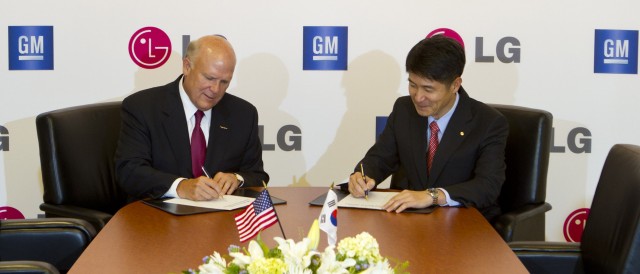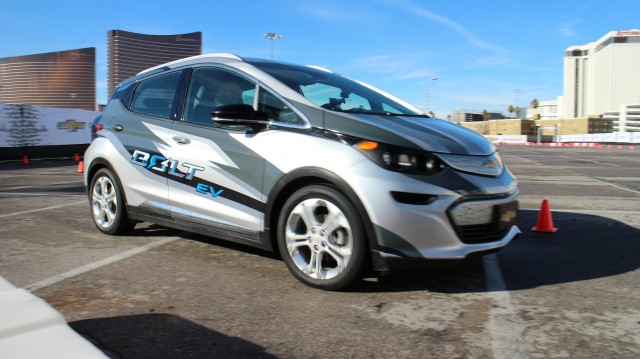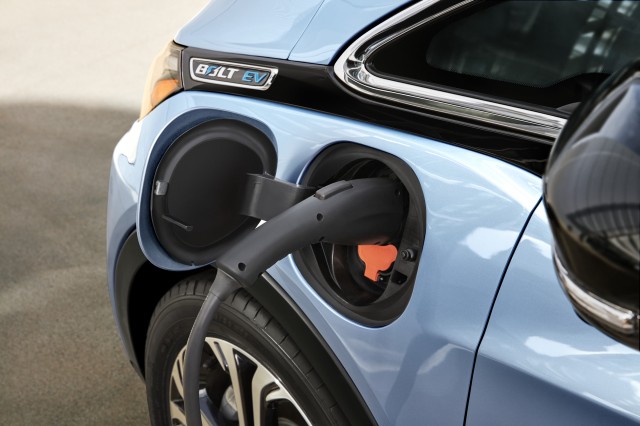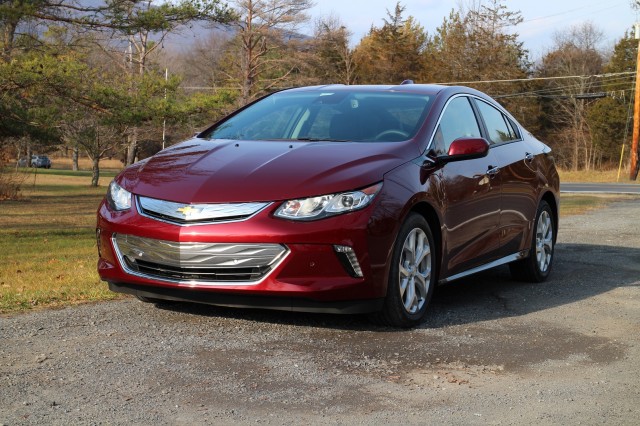In last fall's runup to the launch of the production 2017 Chevrolet Bolt EV 200-mile electric car, GM discussed working together with Korean corporate giant LG on the Bolt's development.
Mark Reuss, GM’s head of global product development said in October that the company's partnership with LG Chem was "unprecedented."
The cooperation was formally announced more than four years ago, in August 2011, by GM's then-CEO Dan Akerson and Juno Cho, president and chief operating officer of LG Corp.
Since then, a few electric-car advocates have suggested that GM had outsourced Bolt EV development wholesale to its Korean partner.
The transcript of an October media roundtable on the strategic partnership--formally titled the "GM-LG Chevrolet Bolt EV Relationship Announcement"--gives more detail on the balance of conceptual, design, specification, testing, validation, and production responsibilities between GM and LG.
GM designed the electric traction motor and the battery-control system, was responsible for all integration of the powertrain into the vehicle itself, and validated all systems.
![Mark Reuss discusses GM-LG Chem partnership on Bolt EV electric car [photo: Jeffrey Sauger for GM] Mark Reuss discusses GM-LG Chem partnership on Bolt EV electric car [photo: Jeffrey Sauger for GM]](http://images.hgmsites.net/med/mark-reuss-discusses-gm-lg-chem-partnership-on-bolt-ev-electric-car-photo-jeffrey-sauger-for-gm_100531144_m.jpg)
Mark Reuss discusses GM-LG Chem partnership on Bolt EV electric car [photo: Jeffrey Sauger for GM]
LG Chem--which supplies lithium-ion cells from Holland, Michigan, for the Chevrolet Volt and Spark EV, and the Cadillac ELR and CT6 Plug-In Hybrid--designed, engineered, and tested the Bolt EV's battery system to performance and packaging specifications supplied by GM.
Other LG units designed and supplied certain other electronic components, as well as the infotainment module for the Bolt EV. The companies include LG Chem, LG Innotek, LG Display, and LG Electronics.
In South Korea, LG Electronics is investing more than $250 million in a Korean facility to support development and manufacturing of components for the Bolt EV, most notably the electric motor.
It will also manufacture the car's power electronics modules to specifications mandated by GM.
Specifically, according to GM , LG Chem will manufacture and supply all of the following systems:
- Lithium-ion Battery Cells and Battery Pack
- Battery Heater
- Electric Drive Motor (GM design)
- Power Inverter Module for DC-to-AC conversion (GM design)
- Onboard Battery Charger
- Electric Compressor for Climate-Control System
- High-Power Distribution Module
- Accessory Low-Power Module
- Power Line Communication Module (for communication with DC quick-charging station)
- Instrument Cluster
- Infotainment System
That list includes parts and assemblies jointly designed by both companies.

GM CEO Dan Akerson & Juno Cho, COO of LG Corp., agree to cooperate on future electric vehicles
LG will deliver 11 unique components for the Bolt EV that it "worked closely with GM in developing," according to Ken Chang, vice president of vehicle components at LG Electronics.
That unit was set up two years ago to allow LG to supply vehicle powertrain components, which it hadn't done previously--although it had long supplied infotainment systems to the global auto industry.
According to Reuss and global electrification director Pam Fletcher at the roundtable, the contract manufacturing model shifts some of the investment needed to build and operate plants to produce those parts from GM to LG.
"We intend to do [better electric vehicles] better, more efficiently, and more cost effectively than anybody else can," Reuss said.
Reuss called the two companies' partnership "a different kind of OEM-supplier relationship" that was an "expansion" of the collaborative work that had started in 2008.
That was when GM awarded LG Chem the cell contract for what became the 2011 Chevrolet Volt range-extended electric car, and resulted in LG and GM "working side by side to develop battery technology that is now the envy of the industry," in his words.
That process "was a true collaborative effort from the beginning," he summarized, "one that set aside the traditional model of product development."
LG's various units, he concluded, are "truly helping us to get to the promised land on batteries and battery-electric vehicles."
More specific details came from Pam Fletcher, who reinforced the side-by-side collaborative nature of the development process.
The collaboration extended to "defining what will this vehicle be, everything from how we are going to package it, what size it should be, what kind of performance it should have," she said, while staying focused on features that would prove most appealing to buyers.
During development, GM's small-vehicle engineering team worked from its Korean unit (the former Daewoo it purchased 15 years ago), while the powertrain team worked out of Warren, Michigan, including its battery lab there.
LG's various teams worked in Korea, vehicle validation was done in various GM facilities in North America, and manufacturing locations include the U.S., South Korea, and other countries as well.

Engineering development version of Chevrolet Bolt EV, Las Vegas, Jan 2016
In response to questions, Reuss said the two companies think "we're able to get...down the cost curve quicker than our competition," but didn't give any hard figures.
(Reuss later told journalists several times that GM would pay $145 per kilowatt-hour for cells it purchased, starting the day the Bolt EV went into production--seemingly to the surprise of LG Chem.)
"We have the capability as a company, obviously, to make all of these components ourselves," Reuss stressed.
He called the allocation of responsibilities a "mix and match," noting as an example that GM doesn't supply its own heating, ventilating, and air-conditioning systems for the cars it builds.
"Some people assume that cost is first and foremost," he said, "but that's not the only driver. This is a space where technology and new ideas are fostered on a very regular basis."

2017 Chevrolet Bolt EV
And, Chang added, LG already manufactures "millions and millions of motors every year," so it brings economies of scale.
The capabilities of a partner like LG, Reuss said, are advantageous in the electric-car segment, which he called "extremely difficult to forecast."
In the end, he said, "that type of relationship pays, for both companies, when we're not building billion-dollar factories."
GM continues to build electric motors for the Chevy Spark EV at a plant in White Marsh, Maryland.
When the Bolt EV replaces the electric Spark, that facility will shift to assembling electric motors for the Cadillac CT6 Plug-In Hybrid model. They will all be exported to China, where that CT6 version is built.

2016 Chevrolet Volt, Catskill Mountains, NY, Dec 2015
Motors for the 2016 Volt are manufactured under contract by Hitachi in Kentucky.
Meanwhile, GM's battery-pack assembly plant in Brownstown, Michigan, continues to build packs for the second-generation Volt plug-in hybrid.
And it will add production of packs for two more vehicles that derive from the Volt powertrain as well: the 2016 Chevy Malibu Hybrid and the CT6 Plug-In Hybrid.
Production of the 2017 Chevrolet Bolt EV electric car is expected to start late this year, with first deliveries possible in December.




No comments:
Post a Comment